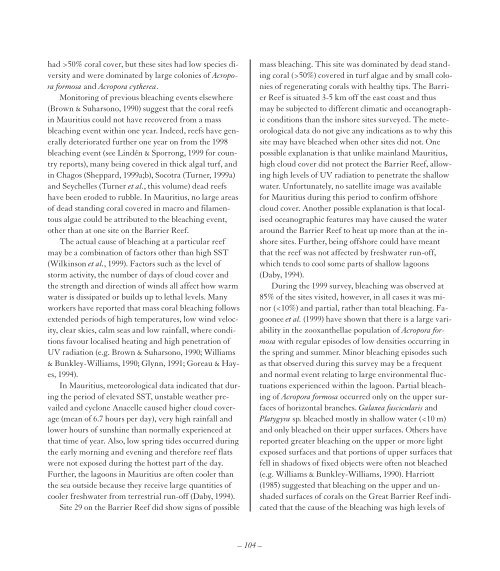Create successful ePaper yourself
Turn your PDF publications into a flip-book with our unique Google optimized e-Paper software.
had >50% coral cover, but these sites had low species diversity<br />
and were dominated by large colonies of Acropora<br />
formosa and Acropora cytherea.<br />
Monitoring of previous bleaching events elsewhere<br />
(Brown & Suharsono, 1990) suggest that the coral reefs<br />
in Mauritius could not have recovered from a mass<br />
bleaching event within one year. Indeed, reefs have generally<br />
deteriorated further one year on from the 1998<br />
bleaching event (see Lindén & Sporrong, 1999 for country<br />
reports), many being covered in thick algal turf, and<br />
in Chagos (Sheppard, 1999a;b), Socotra (Turner, 1999a)<br />
and Seychelles (Turner et al., this volume) dead reefs<br />
have been eroded to rubble. In Mauritius, no large areas<br />
of dead standing coral covered in macro and filamentous<br />
algae could be attributed to the bleaching event,<br />
other than at one site on the Barrier Reef.<br />
The actual cause of bleaching at a particular reef<br />
may be a combination of factors other than high SST<br />
(Wilkinson et al., 1999). Factors such as the level of<br />
storm activity, the number of days of cloud cover and<br />
the strength and direction of winds all affect how warm<br />
water is dissipated or builds up to lethal levels. Many<br />
workers have reported that mass coral bleaching follows<br />
extended periods of high temperatures, low wind velocity,<br />
clear skies, calm seas and low rainfall, where conditions<br />
favour localised heating and high penetration of<br />
UV radiation (e.g. Brown & Suharsono, 1990; Williams<br />
& Bunkley-Williams, 1990; Glynn, 1991; Goreau & Hayes,<br />
1994).<br />
In Mauritius, meteorological data indicated that during<br />
the period of elevated SST, unstable weather prevailed<br />
and cyclone Anacelle caused higher cloud coverage<br />
(mean of 6.7 hours per day), very high rainfall and<br />
lower hours of sunshine than normally experienced at<br />
that time of year. Also, low spring tides occurred during<br />
the early morning and evening and therefore reef flats<br />
were not exposed during the hottest part of the day.<br />
Further, the lagoons in Mauritius are often cooler than<br />
the sea outside because they receive large quantities of<br />
cooler freshwater from terrestrial run-off (Daby, 1994).<br />
Site 29 on the Barrier Reef did show signs of possible<br />
mass bleaching. This site was dominated by dead standing<br />
coral (>50%) covered in turf algae and by small colonies<br />
of regenerating corals with healthy tips. The Barrier<br />
Reef is situated 3-5 km off the east coast and thus<br />
may be subjected to different climatic and oceanographic<br />
conditions than the inshore sites surveyed. The meteorological<br />
data do not give any indications as to why this<br />
site may have bleached when other sites did not. One<br />
possible explanation is that unlike mainland Mauritius,<br />
high cloud cover did not protect the Barrier Reef, allowing<br />
high levels of UV radiation to penetrate the shallow<br />
water. Unfortunately, no satellite image was available<br />
for Mauritius during this period to confirm offshore<br />
cloud cover. Another possible explanation is that localised<br />
oceanographic features may have caused the water<br />
around the Barrier Reef to heat up more than at the inshore<br />
sites. Further, being offshore could have meant<br />
that the reef was not affected by freshwater run-off,<br />
which tends to cool some parts of shallow lagoons<br />
(Daby, 1994).<br />
During the 1999 survey, bleaching was observed at<br />
85% of the sites visited, however, in all cases it was minor<br />
(


















